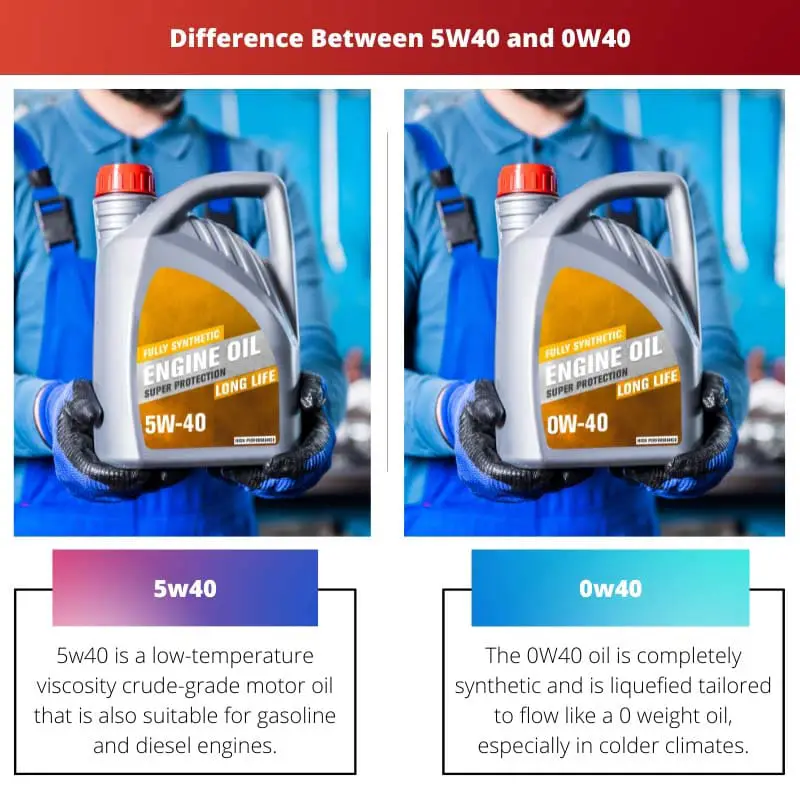Engine oils are one of the most important aspects of keeping an engine running properly.
However, because there are so many different types of oil, drivers are sometimes misled, and they end up using an oil that isn’t right for their engine, causing severe problems in the long run.
Both 0w40 and 5w40 are compatible with light and heavy-duty automobile engines. However, their specs are not identical. Furthermore, while these oils are synthetic, some of the chosen brands favor synthetic blends to pure synthetic inclusion.
Key Takeaways
- 5W40 and 0W40 are multigrade motor oil types, with the numbers representing their viscosity at low and high temperatures.
- 0W40 oil has better low-temperature performance than 5W40 oil, providing improved cold-start protection and reduced wear.
- Both oil types offer similar high-temperature performance, providing adequate lubrication and protection for engines operating in various conditions.
5W40 vs 0W40
The difference between 5W40 and 0W40 is that 5W40 is more suitable for hot weather than colder weather and has a working viscosity of 12.5 to 16.3 mm2/s, whereas 0W40 is more suitable for cold temperatures than hot weather and has a working viscosity of 3.8 to 16.3 mm2/s.

5w40 is a low-temperature viscosity crude-grade motor oil that is also suitable for gasoline and diesel engines. As a result, the rating of 5 is not as concerning as 0w40’s aspects, but it is unquestionably greater.
When the engine is heated and running consistently, 5w40 protects it from wear and strain. It is more cost-effective to use because it has a ten-thousand-kilometer operating life before needing to be replaced.
The 0W40 oil is completely synthetic and is liquefied tailored to flow like a 0 weight oil, especially in colder climates, but to have the viscosity of a 40 weight engine oil when operating temperatures reach high levels.
As a result, the engine receives the appropriate level of protection almost immediately after it is started.
Comparison Table
| Parameters of Comparison | 5W40 | 0W40 |
|---|---|---|
| Cold temperature | Less suitable for cold temperatures | Suitable for cold temperatures. |
| Fuel Economy | Less fuel-efficient | More fuel-efficient |
| Price | Lower | Higher |
| Hot Weather | More suitable | Less suitable |
| Engine Temperature | -35 degrees Celsius | -40 degrees Celsius |
| Working Viscosity | 12.5 to 16.3 mm2/s | 3.8 to 16.3 mm2/s |
What is 5W40?
5W40 is a motor oil that gets to the active components rapidly and provides good lubrication for cars when they first startup. It is made out of a blend of synthetic crude oil and petroleum.
Its viscosity spectrum is on the lower half of the spectrum, as shown by the 5W40 classification. This is advantageous since it allows for easier component movement and less viscous drag at starting.
As a result, 5W40 is now the most extensively used motor oil available.
As per the SAE standard, this oil is suited for cars that are driven up to 15,000 miles per year on a regular basis. It’s also utilized as a starting material for other oils.
This type of oil lubricates at low temperatures and protects against friction-induced wear.
The engine parts are lubricated with 5W40 motor oil when they are most prone to heat and friction damage.
When the outdoor temperature is below 50 degrees Fahrenheit, automotive specialists recommend using 5W40 since it flows more easily in cold temperatures than in hot ones.
The weight or viscosity of engine oil is indicated by the number before W. The higher the number, the thicker the flow in the engine will be. The letter W stands for cold or winter.
This is crude oil that may be used in both leaded and unleaded gasoline vehicles. 5w40 oil has an operating viscosity of 12.5 to 16.3 mm2/s.
Furthermore, in frigid temperatures, the oil enables efficient engine starting and rapid oil circulation, as well as getting the parts moving rapidly.
Because the oil is suitable for use in both cold and hot temperatures, it is efficient and cost-effective for automobile owners who frequently change locations, particularly long-distance travelers who drive from one region to another.

What is 0W40?
Most automakers recommend using 0w40 as a preferred and highly recommended motor oil. It is also a must-have for most European automobiles because it is perfect for use in cold weather.
Big brands like Benz, Volkswagen, Porsche, and Mercedes-Benz also recommend using this motor oil in their vehicles.
Furthermore, 0w40’s viscosity benefit is gaining popularity among American automakers, as it ensures high-performance engines. Furthermore, 0w40 is appropriate for both pickup trucks and cars, as well as diesel and gasoline-powered engines.
The viscosity of the motor oil at low temperatures is indicated by the first number of 0w40. The viscosity at high temperatures is determined by the second number of this oil.
Because the viscosity is low or non-existent, a value of 0 suggests that this oil is excellent in cold weather.
It is, however, still appropriate for use in hot weather. As a result, if you use this oil, you can still use the vehicle on extended travels. However, it is primarily used in cars that operate in colder climes and in the winter.
When the engine reaches its full operating temperature, 0 weight signifies that the oil flows like 0 weight in cold regions and can provide engine protection for 40 weight when the engine reaches its maximum operating temperature.
The outstanding performance of 0w40 provides the viscosity required to maintain the engine’s effective operation, a feature that conventional motor oils lacked.
Even after it has been used to its maximum capacity, the oil continues to deliver great fuel performance, resulting in increased economic benefits.

Main Differences Between 5W40 and 0W40
- The 5W40 motor oil is less suitable for colder climates, while 0W40 is more suitable because 0w40 motor oil is thinner in consistency and less prone to thickening.
- 5W40 is less fuel-efficient in comparison to 0W40 because it is better in the cold, which makes it ideal for fuel economy.
- 5W40 is more affordable than 0W40.
- 5W40 is more suitable for hot weather, whereas 0W40 is less suitable.
- 5W40 is capable of pumping the engine upto –35 degrees Celsius while 0W40 can pump it till –40 degrees Celsius.
- 5W40 has a working viscosity of 12.5 to 16.3 mm2/s, and the working viscosity of 0W40 is 3.8 to 16.3 mm2/s.

References
- https://link.springer.com/article/10.3103/S1068366617040134
- http://phdproject.uni-ruse.bg/files/article/PORTABLE_MOTOR_OIL_QUALITY_CONTROL_SYSTEM.doc
